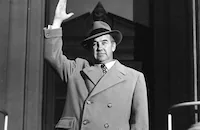Il bidone

Brief Synopsis
Cast & Crew
Federico Fellini
Broderick Crawford
Richard Basehart
Franco Fabrizi
Giulietta Masina
Giacomo Gabriello
Film Details
Technical Specs

Synopsis
Augusto, a shallow, middle-aged, petty confidence man, travels through the Italian countryside with his two companions, the cynical Roberto, and Picasso, the family man, appealing to the greed of the poor in order to pull off cheap swindles. In a favorite ploy, Augusto dresses as a bishop and visits small farms, pretending to find treasure buried by a departed murderer. He turns the "treasure" over to the farmers in exchange for money to celebrate masses for the sinner's soul. Rinaldo, a newcomer who has made money in the drug trade, invites them to his gaudy New Year's Eve party to ridicule their shabbiness. One day Augusto meets his 18-year-old daughter, Patrizia, an enthusiastic student with bright hopes for the future. His paternal feelings aroused, he takes her to a movie where he is shamed and humiliated as one of his victims identifies him and he is arrested before Patrizia's eyes. Upon his release from prison, Augusto finds that Picasso has abandoned the group to rejoin his wife, who has been hurt by the discovery of his criminal activities. Growing increasingly uneasy, Augusto assembles a new crew of con men. In a mechanical repetition of the timeworn treasure swindle, he meets a crippled peasant girl. Forced to hear the confession of a true believer, Augusto is troubled and tries to cheat his companions in order to gain money to help his daughter obtain a job. The other men discover Augusto's duplicity and viciously attack him. Left alone through the night, Augusto dies in anguish.

Director

Federico Fellini
Cast

Broderick Crawford

Richard Basehart

Franco Fabrizi

Giulietta Masina
Giacomo Gabriello
Alberto De Amicis
Lorella De Luca
Sue Ellen Blake
Irene Cefaro
Xenia Valderi
Mario Passante
Crew

Film Details
Technical Specs

Articles
Il Bidone aka The Swindle
As the title suggests, Il Bidone is about a swindle, or rather a series of swindles, some successful and others not. The swindlers are a trio of small-time con artists: Bruno is a part-time painter with a wife and child to support; Roberto is a would-be pop singer; and ringleader Augusto is an aging crook who fears that his estranged daughter will find out how he makes his living. The story opens with one of their typical cons. Driving to a poor little farm in the countryside, they pretend to be priests looking for jewelry buried by a killer along with the bones of his victim, all planted in advance by Augusto and company. When the scammers "find" the buried booty, they offer it to the impoverished farmers on condition that they put up immediate money to pay for masses for the dead man's soul. The tricksters then pocket the money and drive back to the city, heedless of the hardship they've inflicted on people whose hardscrabble existence leaves them not a single lira to spare.
Other cons follow, along with revelations about the hoaxers. Each emerges as a fully rounded character, as does Bruno's wife, Iris, who has strong suspicions but no definite knowledge regarding her husband's illicit livelihood, rather like Carmela Soprano of The Sopranos. Tensions start growing among the three fraudsters, and the law eventually catches up with one of them. Although the overall mood of the film is lightly suspenseful, the climax arrives with a joltingly unexpected plot twist and the finale is starkly tragic, relieved only by the knowledge that a sort of rough justice has finally been served on at least one of the crooked main characters.
Italian studios have always liked to shoot their films without sound and dub in the dialogue later, which explains the discrepancy between voice and image that are a trademark of Italian movies. Under this system filmmakers can easily bring in foreign actors who don't speak Italian fluently, and Fellini took full advantage of that when he cast Anthony Quinn and Richard Basehart in La Strada and then invited Basehart back for Il Bidone along with Crawford, who had won the Academy Award for Best Actor with his work in Robert Rossen's political drama All the King's Men (1949). Crawford's scowling face and burly frame are ideal for the immoral Augusto, and Basehart complements him with an innocent handsomeness - at one point his character brags about looking like an angel - that induces victims to trust him despite their better judgment. Masina is also excellent, steering away from the mugging of La Strada and paving the way for her award-winning performance in The Nights of Cabiria. Fellini's growing artistic confidence was clearly helped by his frequent collaborators behind the camera: screenwriters Ennio Flaiano and Tullio Pinelli, cinematographer Otello Martelli and composer Nino Rota, whose score for Il Bidone is an indispensable part of its dark magic. All make superb contributions to this unjustly neglected gem.
Director: Federico Fellini
Producers: Silvio Clementelli, Charles Delac, Mario Derecchi, Goffredo Lombardo
Screenplay: Federico Fellini, Ennio Flaiano, Tullio Pinelli
Cinematographer: Otello Martelli
Film Editing: Mario Serandrei, Giuseppe Vari
Production Design: Dario Cecchi
Music: Nino Rota
With: Broderick Crawford, Giulietta Masina, Richard Basehart, Franco Fabrizi, Sue Ellen Blake, Irene Cefaro, Albert De Amicis, Lorella De Luca, Giacomo Gabrielli, Riccardo Garrone
BW-92m.
By David Sterritt

Il Bidone aka The Swindle
Quotes
Trivia
Notes
Filmed in Italy and released there in 1955. Shown at the Venice Festival at 109 min; cut to 100 min for Rome opening; Paris opening: February 1956; running time: 108 min. Also known in the U. S. as The Swindle.

Miscellaneous Notes
Released in United States 1955
Released in United States 1962
Shown at the 1955 Venice Film Festival.
Fellini's sixth feature.
Released in United States 1955 (Shown at the 1955 Venice Film Festival.)
Released in United States 1962













